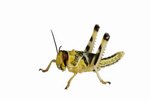Ten-lined June beetles, also known hissing beetles or watermelon beetles, are native to western North America. They begin life as grubs, or larvae, feeding mostly on roots. As adults, ten-lined June beetles leave their former habitat in the soil to live above ground, and forage.
Time for Some Grub
Ten-line June beetles begin life as large white grubs, ranging from one-half inch to 2 inches in length. Their small heads are brown, and they sport three pairs of legs on their upper thorax. At the very tip of their abdomens, recently fed grubs reveal the dark brown contents of their stomachs.
The grubs hatch from eggs buried near the young roots of trees. These roots act as a food source for the growing larvae. During colder months, the larvae will burrow deeper in the soil and migrate up toward the surface when the weather is warmer. The larval stage of the ten-lined June beetle can last from two to four years.
In captivity, the grub stage of the ten-lined June beetle requires plenty of substrate and sandy soil. For food, distribute decaying bark and roots from oak, birch, chestnut or fir trees, which are indigenous to the ten-lined June beetle's natural environment. Dry cat food that has been moistened with water also serves as an appropriate supplement for growing larvae.
Hiding in Their Food
Adult ten-lined June beetles emerge in the warm summer months, after going through a pupa, or chrysalis, stage that lasts about five weeks. Once they exit their emergence hole, the ten-lined June beetle will spend its day hiding in long grasses only to become active at dusk, flying around to find mates. Male June beetles are attracted to light, and can be found in large groups around porch lights and streetlamps.
Sometimes referred to as "hissing beetles," ten-lined June beetles are so called because of their defense mechanism. When disturbed, these beetles stridulate, or rub their wings against their abdomens, forcing air out and making a distinctive hissing sound.
Adult June beetles in the wild will feed on plants and leaves, most often needles from conifer trees, taking one long needle into their mouths and nibbling it from end to end. Their unique striation, or striping, serves as a form of camouflage in a pile of green pine needles. In captivity, conifer foliage and sugary fruits such as bananas or apples will provide plenty of nutrition.
Oops, I Ate It Again
In the wild, the large appetites of ten-lined June beetle larvae spell danger for small orchards. Hungry grubs can stunt tree growth, cause injury or even kill local trees. While the adults don't pose a threat, wild June beetle larvae infestation is potentially disastrous, and can be spotted by evidence of trees that are stressed or stunted, despite sufficient watering.




